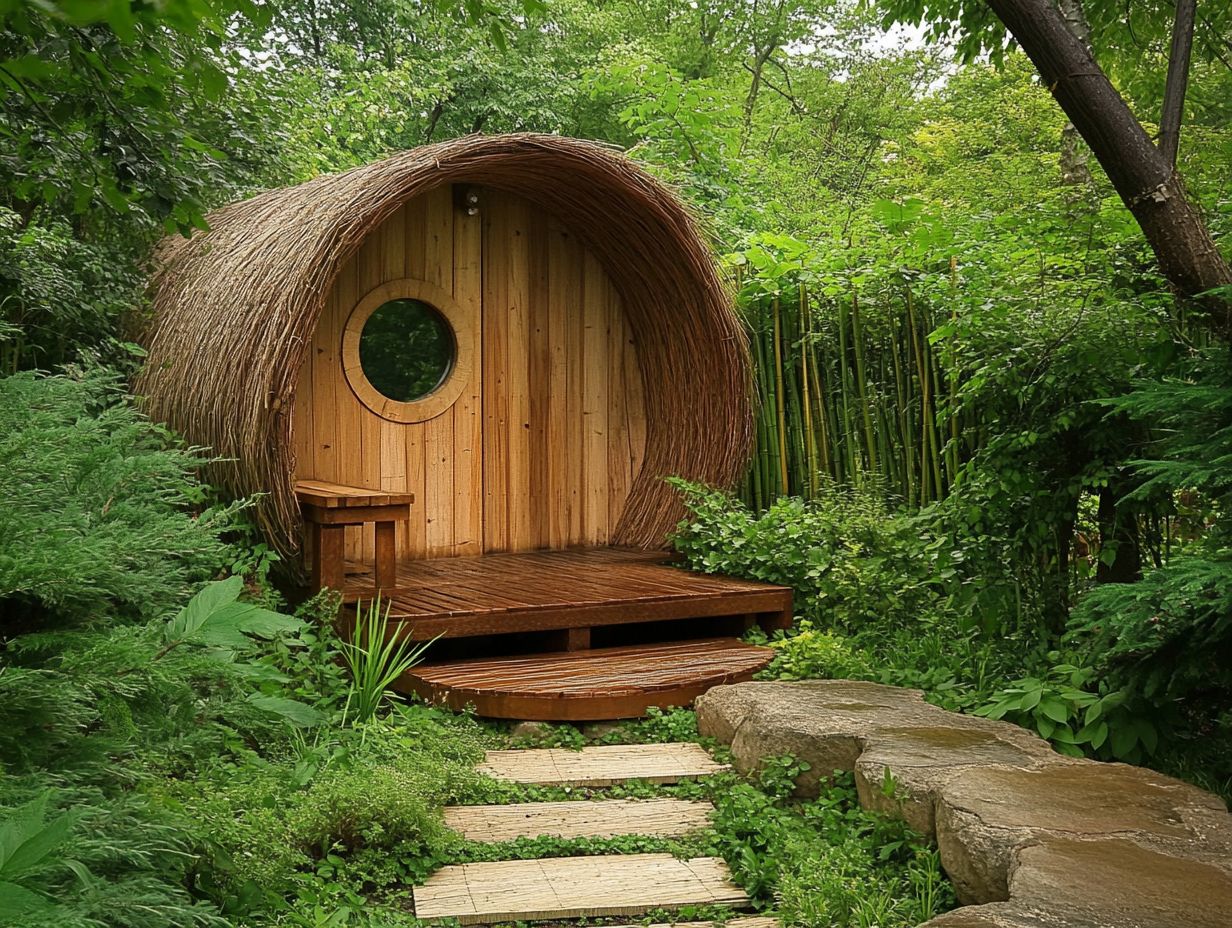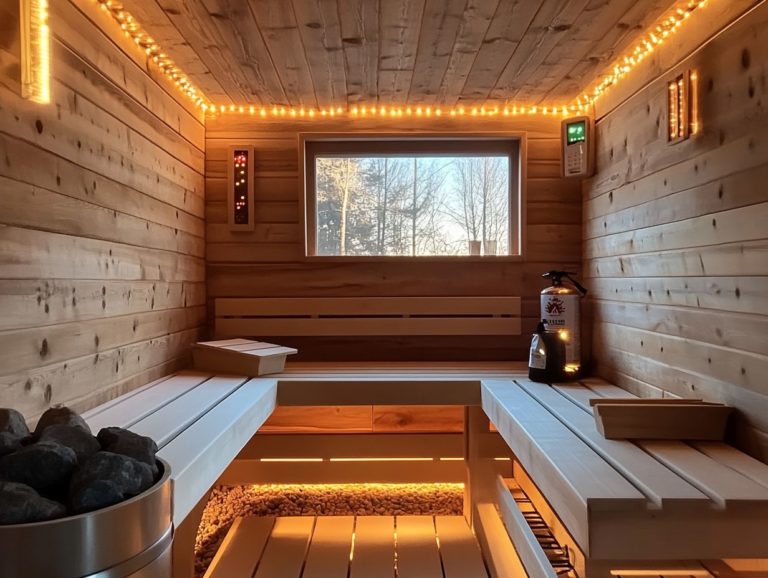“5 Eco-Friendly Materials for Your DIY Sauna”
Building a sauna is an exciting opportunity to enhance your well-being and the planet’s health! Selecting the right materials is essential for achieving both goals.
Here are five eco-friendly options to consider:
- Bamboo (including Canadian cedar)
- Cork
- Recycled glass
- Reclaimed wood
- Natural stone
These choices not only elevate the aesthetics of your sauna but also promote sustainability in your outdoor space.
Explore the environmental impacts of traditional materials. Discover the benefits of embracing green alternatives like infrared sauna technology, and find out how you can enjoy long-term savings while crafting your serene retreat.
Empower yourself to make informed choices for your DIY sauna!
Contents
- Key Takeaways:
- 1. Bamboo
- 2. Cork
- 3. Recycled Glass
- 4. Reclaimed Wood
- 5. Natural Stone
- How Can Using Eco-Friendly Materials Benefit Your Sauna?
- What Are the Environmental Impacts of Traditional Sauna Materials?
- How Can Eco-Friendly Materials Enhance the Sauna Experience?
- What Are Some Other Eco-Friendly Alternatives for Sauna Building?
- What Are the Long-Term Cost Savings of Using Eco-Friendly Materials?
- How Can You Ensure the Materials Used for Your Sauna Are Truly Eco-Friendly?
- Your Eco-Friendly Sauna Questions Answered!
- What are the top 5 eco-friendly materials for building a DIY sauna?
- Why is it important to use eco-friendly materials for a sauna?
- Where can I find sustainably sourced wood for my DIY sauna?
- Can I use recycled denim insulation for my sauna?
- Are there any eco-friendly options for sauna heating?
- How can I incorporate sustainable design into my DIY sauna?
Key Takeaways:

Using eco-friendly materials in your sauna benefits the environment by reducing waste and harmful toxins.
Traditional sauna materials can negatively impact the environment, such as causing deforestation and pollution. Choosing sustainable alternatives helps to mitigate these effects.
Eco-friendly materials like bamboo and cork enhance the sauna experience and health benefits with their natural properties.
1. Bamboo
Bamboo is rapidly becoming the go-to choice for sauna enthusiasts seeking eco-friendly materials for outdoor projects. Its remarkable growth rate and sustainability make it an ideal option for both sauna kits and DIY builds.
This versatile material supports a sustainable lifestyle while elevating your sauna experience with unique aesthetics and natural moisture resistance. It perfectly aligns with minimalist design and modern environmental values.
The natural properties of bamboo provide exceptional heat retention, allowing for a more efficient warming process. This efficiency leads to energy savings that are increasingly essential in today s eco-conscious landscape.
The rich, warm hues of bamboo create a calming atmosphere that enhances both indoor and outdoor sauna spaces. Its flexibility opens up a world of possibilities, from structural beams to decorative accents, ensuring your sauna is both functional and visually captivating.
By embracing bamboo in your sauna construction, you’re making a statement about your commitment to sustainability and innovative design.
2. Cork
Cork is an exceptional eco-friendly material for your sauna, celebrated for its ability to keep heat. These qualities help maintain a consistent temperature, enhancing your overall sauna experience while significantly reducing energy consumption.
Its inherent moisture resistance ensures that cork remains stable and durable even in the humid environment typical of saunas. This durability prolongs the lifespan of your sauna and keeps maintenance costs in check.
Cork’s natural aesthetics blend well with many design styles, adding a touch of elegance to your space and elevating the ambiance. With all these outstanding attributes, cork truly stands out as a premier choice, supporting the longevity of sauna installations while contributing to their energy efficiency.
Start your sauna journey today by choosing eco-friendly materials!
3. Recycled Glass
Recycled glass is a unique choice for sauna design. It blends eco-friendliness with practical advantages like moisture resistance and aesthetic versatility.
This material is perfect for sauna enthusiasts looking to enhance their outdoor sauna experience. The shimmering surfaces create a striking visual contrast against the natural wood used in sauna construction.
Using recycled glass in your sauna promotes effective ventilation. It allows better airflow while retaining heat, ensuring a comfortable atmosphere for each sauna session.
4. Reclaimed Wood

Reclaimed wood stands out as a premium choice for crafting eco-friendly saunas. It is lauded for its sustainable nature and unique character.
This remarkable material not only reduces environmental impact by repurposing existing resources but also weaves a rich narrative that connects you to the past. Each sauna session becomes more meaningful.
Varieties like cedar and pine are celebrated for their excellent heat retention. These ensure that your sauna remains warm and inviting, even on the coldest days.
Beyond functionality, these wood types enhance the aesthetic appeal of your space. They create a warm, rustic ambiance that elevates your relaxation experience.
5. Natural Stone
Natural stone is an exquisite choice for sauna construction. It offers robust thermal insulation alongside a stunning aesthetic.
You often find varieties like granite, slate, and marble in saunas. Each provides unique characteristics that boost durability and enhance thermal qualities essential for efficient heating.
Take granite, for example. It’s renowned for its ability to retain and gradually release heat, making it an energy-efficient choice.
Slate, with its natural textures and colors, beautifully complements contemporary designs, creating a calming atmosphere that invites relaxation.
Meanwhile, marble adds a touch of luxury, blending heat retention with elegance, further elevating the ambiance of your sauna space.
How Can Using Eco-Friendly Materials Benefit Your Sauna?
Utilizing eco-friendly materials in your sauna construction complements a sustainable lifestyle and enhances your sauna experience. You ll enjoy improved energy efficiency and a reduced environmental impact.
Incorporating these materials translates to enhanced thermal insulation, enabling quicker heating and cooler cooldowns. This leads to lower overall energy consumption, reducing utility bills and your carbon footprint.
Choosing eco-friendly materials improves indoor air quality by reducing harmful chemicals in the air. As a result, your sauna sessions become more pleasurable and contribute positively to your well-being.
What Are the Environmental Impacts of Traditional Sauna Materials?
Traditional sauna materials often come with significant environmental consequences. They contribute to deforestation and increase the carbon footprint, highlighting the urgent need for sustainable materials in sauna construction.
Softwoods like cedar and spruce are frequently harvested irresponsibly, risking biodiversity and soil health. In contrast, innovative eco-friendly alternatives such as reclaimed wood and bamboo offer sustainable solutions.
These choices not only reduce deforestation but also align with sustainable forestry practices, emphasizing responsible sourcing and regeneration.
By opting for sustainably sourced products, you can protect natural resources and ensure a healthier planet. Such decisions reflect our collective responsibility to embrace sustainability in all aspects of construction, fostering a more harmonious relationship with the environment.
How Can Eco-Friendly Materials Enhance the Sauna Experience?

Incorporating eco-friendly materials into your sauna design can elevate your experience in remarkable ways. These materials enhance health benefits, boost energy efficiency, and create a more inviting atmosphere for every session.
They improve air quality with their non-toxic nature and blend seamlessly with natural elements, encouraging relaxation. By choosing sustainably sourced wood and eco-friendly insulation, your sauna becomes a sanctuary that positively influences both your psychological and physical well-being.
You ll be surrounded by calming visuals and the soothing scents of natural wood, fostering tranquility and relieving stress. The reduced release of volatile organic compounds ensures a cleaner environment, boosting comfort and making each sauna visit a revitalizing retreat for both mind and body.
What Are Some Other Eco-Friendly Alternatives for Sauna Building?
Beyond bamboo, cork, and reclaimed wood, there are numerous eco-friendly alternatives for building your sauna. These options align with a sustainable lifestyle and enhance energy efficiency, ensuring a low-impact yet luxurious experience.
Consider straw bales; they offer exceptional insulation properties and are a cost-effective choice for maintaining the perfect temperature inside your sauna. Their natural composition makes straw bales biodegradable with a minimal environmental impact.
Hempcrete is another cutting-edge option made from hemp fibers blended with lime. This lightweight yet robust material regulates moisture and sequesters carbon, providing significant ecological benefits.
Don’t overlook recycled metal, either. Using it for roofing or accents boosts durability while minimizing waste. Each of these materials enhances both the aesthetic charm of your sauna and its sustainability profile.
What Are the Long-Term Cost Savings of Using Eco-Friendly Materials?
Investing in eco-friendly sauna materials is a brilliant choice that pays off in significant long-term savings. By reducing energy consumption, extending your sauna’s lifespan, and minimizing maintenance, you’ll find the benefits accumulate over time.
Eco-friendly materials often feature superior insulation properties, optimizing heat retention and resulting in lower energy bills. Research indicates that using sustainably sourced wood instead of conventional materials can cut heating costs by up to 30%.
Durability is another advantage of eco-friendly options like bamboo or reclaimed wood, which resist wear and tear more effectively than traditional materials. A case study from a wellness retreat in Colorado showed that their eco-friendly sauna required 50% fewer repairs each year compared to standard models, underscoring the immediate and long-term advantages of a greener approach.
Make your sauna a sanctuary by choosing sustainable materials today!
How Can You Ensure the Materials Used for Your Sauna Are Truly Eco-Friendly?
To ensure the materials used for your sauna are genuinely eco-friendly, seek materials that are certified as sustainable and check where they come from. Consider acquiring a building permit that encourages environmentally responsible construction.
As you embark on this journey, look for certifications like the Forest Stewardship Council (FSC) or the Global Organic Textile Standard (GOTS). These can help validate the eco-friendliness of the products you choose.
When engaging with suppliers, don t hesitate to inquire about their sourcing methods and whether their materials come from renewable resources. Look closely at how different options impact the environment! Evaluate the sustainability of products by assessing their life cycle impact, or how materials affect the environment over their entire life, and energy efficiency.
Transparency from suppliers about their practices is crucial. Companies dedicated to sustainable methods often share their sourcing information and certifications openly, empowering you to make informed choices about the materials that will ultimately help you create a truly green sanctuary!
Your Eco-Friendly Sauna Questions Answered!

What are the top 5 eco-friendly materials for building a DIY sauna?
The top 5 eco-friendly materials are sustainably sourced wood, recycled denim insulation, low-VOC paint, natural stone or clay tiles, and LED lighting.
Why is it important to use eco-friendly materials for a sauna?
Using eco-friendly materials helps reduce the environmental impact of your DIY sauna and promotes sustainability. These materials also tend to be healthier for both you and the planet.
Where can I find sustainably sourced wood for my DIY sauna?
Sustainably sourced wood can be found at your local lumberyard, home improvement store, or online retailers. Just make sure to look for certification labels such as FSC or SFI to ensure the wood is responsibly harvested.
Can I use recycled denim insulation for my sauna?
Yes, recycled denim insulation is a great eco-friendly option for a sauna. It is made from post-consumer recycled denim, making it a sustainable and non-toxic choice.
Are there any eco-friendly options for sauna heating?
Yes, using a wood-burning stove or infrared panels are both eco-friendly options for heating your sauna. They use less energy and produce fewer emissions compared to traditional electric heaters.
How can I incorporate sustainable design into my DIY sauna?
In addition to using eco-friendly materials, you can also incorporate sustainable design elements such as natural ventilation, energy-efficient windows, and using passive solar heating techniques. Start your journey to a sustainable sauna today!






